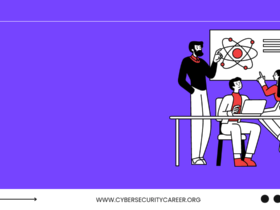Some of the fastest-growing and highest-paying occupations are available in the STEM (science, technology, engineering, and mathematics) industries. But racial and gender diversity tends to be lacking in these sectors.
Long-term studies frequently exclude nonbinary genders and confuse terminology for sex (such as “woman”) with terms for gender (e.g., “female”). Despite this, statistics show that women are underrepresented in cybersecurity despite making up nearly half of STEM professionals overall.
According to Pew Research Center, women make up only 25% of the workforce in the computer industry. Similarly, according to industry analysts, women will hold 25% of all cybersecurity professions by the end of 2021.
Increasing the number of women working in cybersecurity will help them launch successful careers in this expanding industry. In addition, a more diverse workforce can benefit the sector by offering a range of viewpoints and approaches to problem-solving.
Long-term studies frequently exclude nonbinary genders and confuse terminology for sex (such as “woman”) with terms for gender (e.g., “female”).
To encourage and support historically underrepresented groups, such as women, in their tech endeavors, the area of technology requires greater resources. The advantages of diversity in technology and the prospects for women in cybersecurity are covered in this handbook.
A Synopsis of Cybersecurity History
Computer systems are shielded against attacks by bad actors by cybersecurity experts. The first computer worm and antivirus programs, Reaper and Creeper, respectively, were developed by researchers in the 1970s, marking the beginning of the field of cybersecurity.
In the 1980s, commercial antiviral applications first appeared. However, professional cyberattacks increased in the 1990s and 2000s. Since then, dangers to information security have increased as society has shifted to relying on computers for many parts of daily life.
Cyberattacks will cost the United States more than $4 billion in 2020. The need for professionals with cybersecurity skills will probably increase as cyberattacks become more frequent. Information security analysts are expected to have above-average job growth (33 percent) between 2020 and 2030, according to the Bureau of Labor Statistics (BLS).
Demographics of Cybersecurity
According to trends in the IT industry, men outweigh women in cybersecurity by a wide margin. Women received 19% of bachelor’s degrees in computer science in 2017–18, a 1% increase since 2014.
In 2013, just 11% of information security professionals were women. After some time, this percentage rose to 25%. However, with only 47% of STEM employees being women, cybersecurity still has a long way to go.
Women received 19% of bachelor’s degrees in computer science in 2017–18, a 1% increase since 2014.
Notably, nonbinary genders are not included in these data. In research, “woman” and “female” are frequently used interchangeably. Despite some recent advancements, the evidence clearly shows that women are underrepresented in cybersecurity despite these flaws.
Why aren’t more women working in cybersecurity?
It would be beneficial to understand the root causes of the shortage to close the gap and bring female representation close to 50 percent. It’s simple to generalize the issue as gender bias or discrimination, but providing more context for the issue should aid in identifying remedies.
If simple gender bias was determined to be the cause of the issue, the age-old solutions of educating employers about the value women bring to the workplace and perhaps educating males of the same from a young age would apply. A few study publications that have recently been released help to clarify the issues: Government Technology used some high school cybersecurity camps as an opportunity to gain insight into what teenagers think about their career prospects in the industry; A joint report by NBC and The Hechinger Report was published in April 2018; Forbes magazine published a summary of a study that appeared on Quora in January 2018;
Evidence demonstrates that young females develop prejudices about their role in the world frequently during or even before high school. Teenage girls are still developing beliefs that will later significantly restrict their professional options, despite the media’s focus on all the wonderful improvements that have given women greater opportunities. It appears that parental influences in some households, as well as other societal ideals, continue to discourage girls from pursuing technical careers.
Young women frequently believe cybersecurity is a field where they must achieve far more than men do to be treated equally. However, even some schoolgirls have already realized that boys are better suited for technical occupations than girls. In reality, according to recent evidence, this is frequently and sadly accurate.
Scholarships and other resources for women
The number of financial and non-financial support programs for women looking to work in cybersecurity or other STEM fields is growing.
These possibilities are connected to formal education, professional development, and certification. In addition, by partnering with InfoSec, Inc., and CompTIA, they can provide women interested in cybersecurity jobs with significant financial aid through scholarships that cover the cost of cybersecurity boot camps. The Information Assurance Scholarship Program is a scholarship-for-service opportunity provided by the US Navy to both men and women.
In addition to (ISC)2, the Center for Cyber Safety and Education provides women pursuing a bachelor’s or master’s degree in cybersecurity with a $40,000 stipend. Scholarships for Women Studying Information Security (SWSIS) is a scholarship program for women pursuing a bachelor’s or master’s degree in a cybersecurity area. It is a collaboration between Applied Computer Security Associates (ACSA) and CRA-WP.
Additionally, Raytheon offers women studying cybersecurity an $8,000 scholarship. The Scopes Educational Scholarship Program is offered by the National Security Agency (NSA) to high school seniors who have exhibited proficiency in the required fields of computer science and electrical engineering and who intend to study in one of these fields, including cybersecurity. In addition to summer employment, the CIA offers several internship programs that award successful applicants with tuition reimbursement. Cybersecurity is included in the areas of intelligence that are the emphasis.
Role models for women in cybersecurity
There are many accomplished women in the world of cybersecurity today who might serve as inspirations to younger women and perhaps even serve as mentors.
These role models understand what it takes to get beyond obstacles and should be used as an example for young girls to show that it is possible. Successful women can be seen at trade shows where they are given a chance to be keynote speakers or in online video interviews with female cybersecurity leaders. WiCyS provide role models for these female infosec professionals.
The Advantages of More Women in Technology
Tech diversity has several advantages. Innovation can result by including a wider range of perspectives, experiences, and problem-solving techniques. According to a 2018 study, businesses with above-average management diversity generated 19% more revenue than those with below-average management diversity.
Companies are missing out on a sizable talent pool if women are underrepresented on their cybersecurity teams. There is a shortage of qualified cybersecurity specialists. The advantages of expanding the talent pool are made clear by this. Employing and advancing women in cybersecurity should be a priority for businesses that want to remain competitive.
Benefits for Industries and Sectors
Address the Workforce Deficit: Promoting diversity in technology can assist in addressing the cybersecurity labor shortage. Businesses that require cybersecurity experts may benefit from a bigger talent pool if more women choose to work in this field.
Encourage Innovation and Creativity: A diverse workforce can encourage innovation and creativity. This promotes the advancement of industries and the creation of new technology, which increases revenues.
Benefits for Teams and Companies
Companies of all shapes and sizes benefit from having more women working in cybersecurity. Teams in companies with more female employees can profit as well.
- Diverse Perspectives: Women often bring viewpoints that contrast with those of men. Teams of members from both genders may thus have access to fresh perspectives and approaches to problems.
- Learning Possibilities: Employers with a diverse workforce offer staff members the chance to educate themselves about others. This can help people comprehend various cultures, races, and genders better.
- Better Support for Women in the Industry: By encouraging more women to work in cybersecurity, better working conditions may be created for existing and future female employees. These professionals can connect with mentors, uncover possible role models, and feel less alone.
Occupational and Financial Prospects for Women in Cybersecurity
Women in cybersecurity can pursue in-demand professions with wages above the national average. For those looking for a steady position with opportunities for advancement, cybersecurity may be a wise career decision as it is a rapidly expanding, high-paying industry.
There is a shortage of cybersecurity experts compared to demand. For instance, the BLS forecasts a 33 percent job growth (far faster than average) for information security analysts between 2020 and 2030. However, by accumulating experience, going to college, and obtaining qualifications, cybersecurity experts can rise into positions like security consultants or chief security officers.
As of May 2020, the median annual pay for information security analysts was $103,590, which is much more than the $41,950 national average. Overall, STEM professionals make more money than people in other professions. However, across all racial and ethnic groupings, women in technology make less money than men in comparable positions.
One of many possible obstacles for women in cybersecurity is the pay difference between men and women in technology.
$103,590
Reference: BLS
Associations for Professional Women in Cybersecurity
- Women in Cybersecurity: Founded in 2012, this organization works to bring in, keep, and support female professionals in this area. Members have access to conferences, employment fairs, and professional development programs.
- The Women’s Society of Cyberjutsu (WSC) is a nonprofit organization that promotes the importance of women in cybersecurity and works to close the gender gap in the field. The group provides webinars, local chapters, training opportunities, and job information.
- The Executive Women’s Forum (EWF) fosters the advancement of women in technology via professional growth and education. Members have access to leadership possibilities, a private social network, and an annual conference.
- Women CyberSecurity Society: This nonprofit organization is the only one for women in cybersecurity in Canada. The group provides advantages like volunteer opportunities, mentoring, and practical learning.
- She Secures: She Secures the professional aspirations of women in cybersecurity. The company arranges networking events, internship chances, and mentoring sessions.
Common Questions Regarding Women in Cybersecurity
What proportion of women works in cybersecurity?
By the end of 2021, according to industry experts, women will account for 25% of the cybersecurity workforce globally. This figure shows how underrepresented women remain in the profession but also represents a 5 percent rise since 2019.
Why do women work in cybersecurity at a lower rate than men?
There are numerous reasons why there are not enough women working in cybersecurity. Gender bias, income disparities, the limited percentage of women who receive degrees in computer-related fields, and the lack of female role models in leadership roles are a few of the causes.
Are there any changes in cybersecurity demographics?
Yes, there are gradually more women working in cybersecurity. For example, only 20% of cybersecurity professionals were women in 2019, but that percentage is expected to rise to 25% by the end of 2021.
Why is technological variety important?
People from traditionally marginalized groups can now access well-paying positions in tech, thanks to diversity. Additionally, diversity can help businesses be more innovative, creative, and profitable. Diversity promotion in the cybersecurity industry can aid in addressing the labor deficit there.
Future of women in cybersecurity
The goal of increasing gender parity in the cybersecurity industry is attainable as more women are drawn to STEM professions like cybersecurity. Women should expect more possibilities to open up and stay open to them, especially given the skill scarcity in cybersecurity that businesses worldwide are experiencing. In addition to encouraging businesses to regard women as equal employees to men, the rise in female participation in cybersecurity advocacy groups and organizations will also raise the likelihood that more women will join the global cybersecurity industry.










Leave a Reply